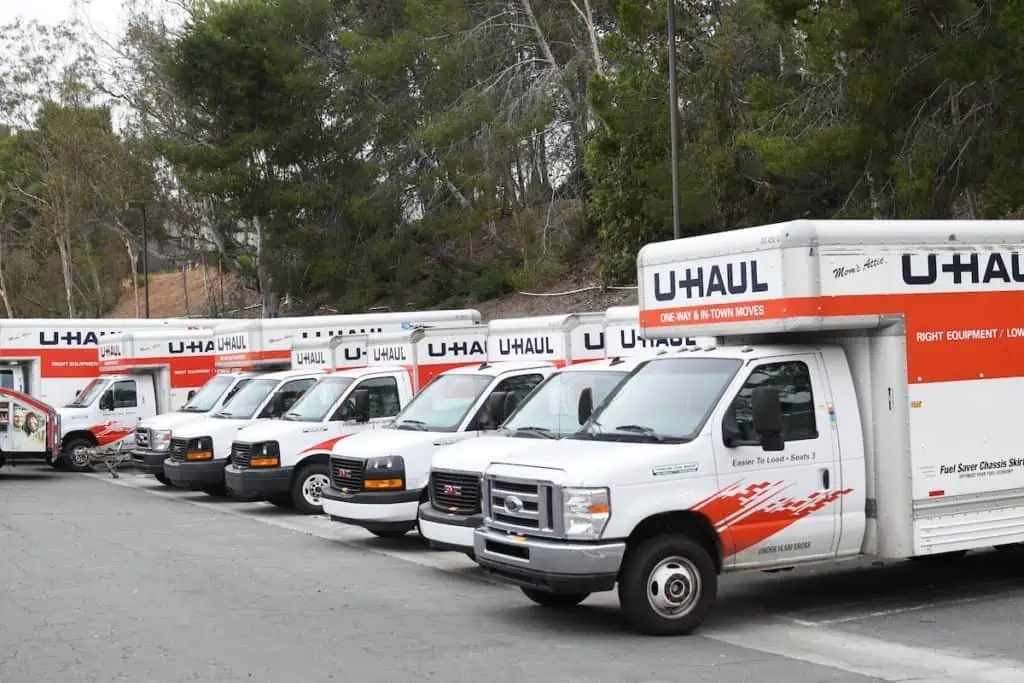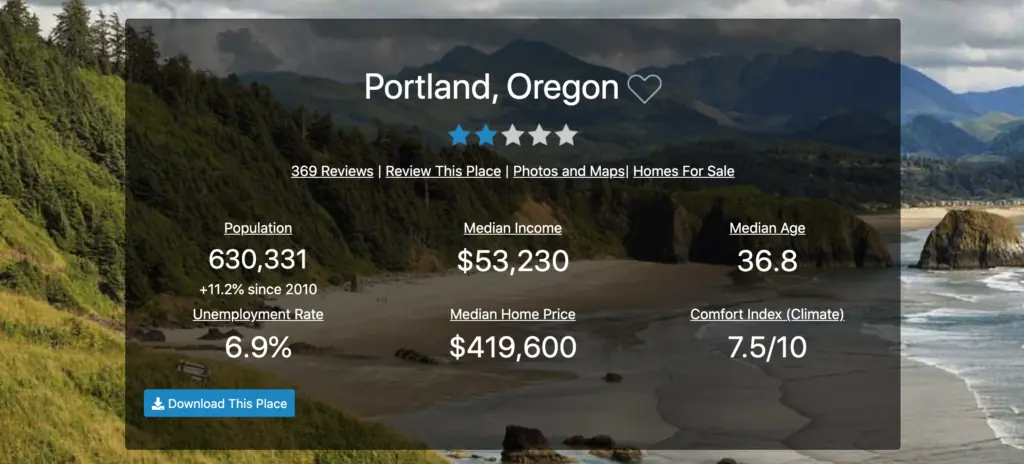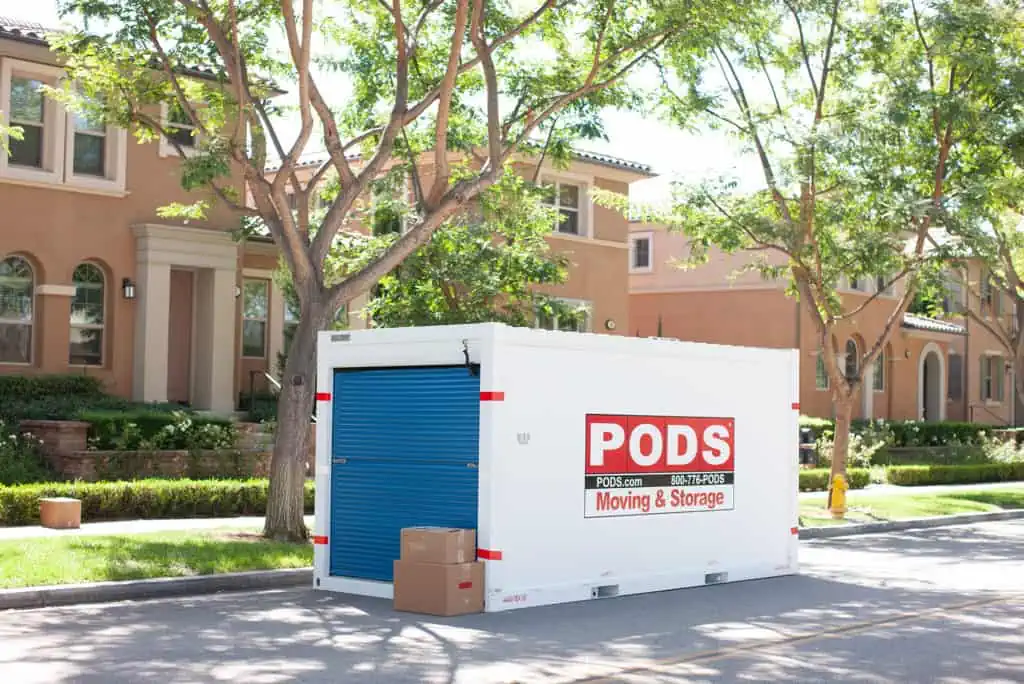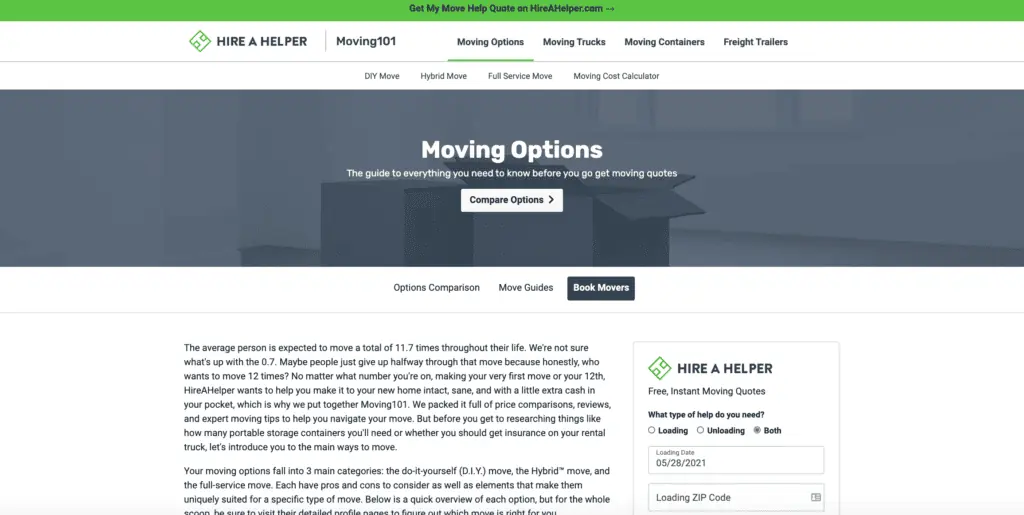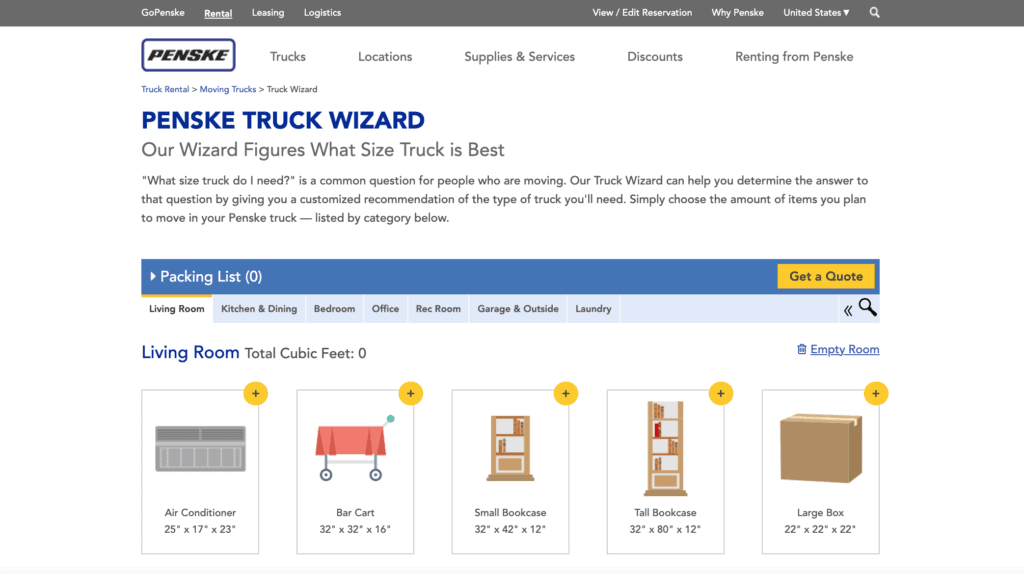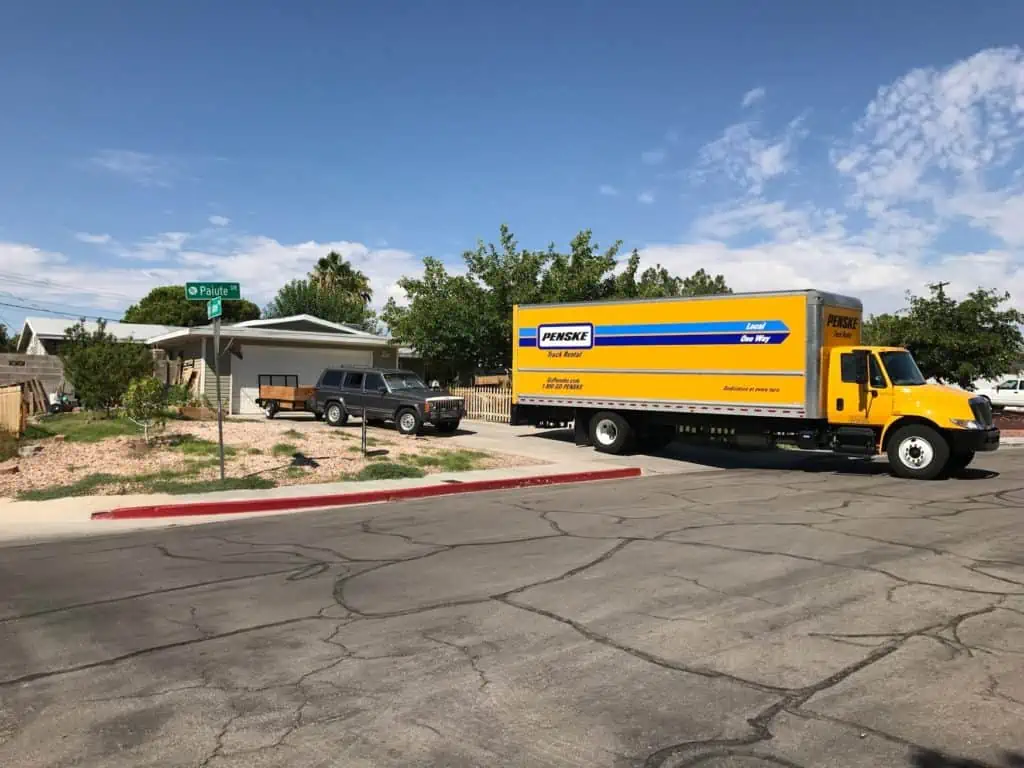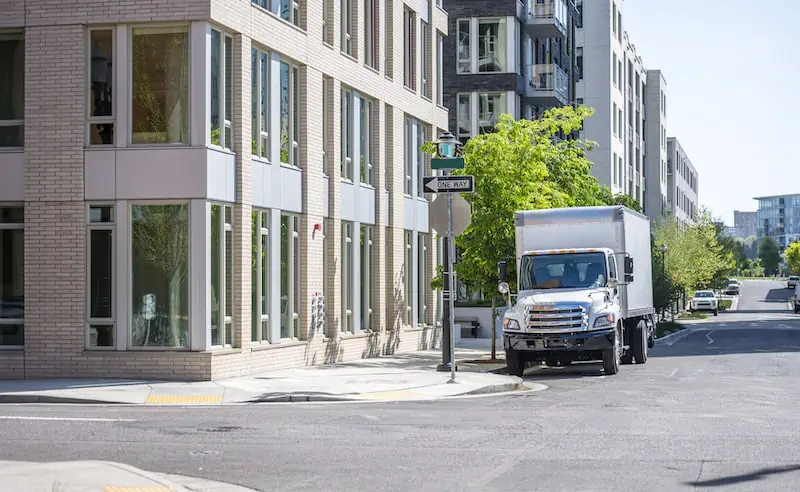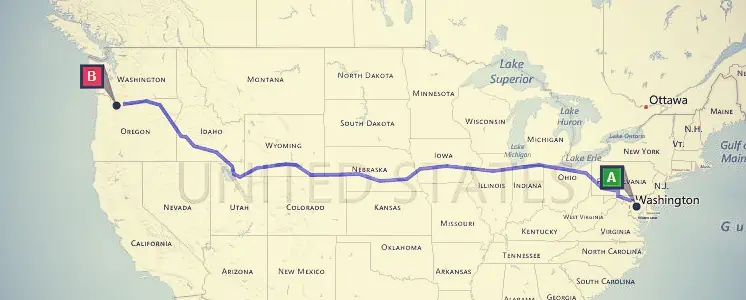Each year, 9.8% of Americans move—and a third of those relocate to a new state. So if you’re thinking about moving from Los Angeles to New York City, you’re in good company.
But before you ditch the idyllic temps and less-than-idyllic traffic of L.A. for the skyscrapers and snowstorms of NYC, there are some key details to think through:
- How much does a cross-country move cost?
- What exactly does a cross-country relocation entail?
- What does it mean for your car?
As someone who grew up in L.A., I understand all of the amazing qualities of this sprawling city, but I also know why, after a while, you might want to try something new. After all, New York City is a big place, with 8 million people, 5 boroughs, and about 3,000 “best slice” spots. Here’s what I learned on my move.
From Coast to Coast: What You Need To Know When Moving from LA to NYC
As Frank Sinatra crooned, “If you can make it here, you’ll make it anywhere.” Of course, that implies it takes some fortitude to make it in NYC. (As a Los Angelino, you’ve already got that in spades.)
Here are a few key differences to consider between the two cities:
- Transportation: Los Angeles is a driving-centric town; you must have your own vehicle in L.A. But the traffic is atrocious, and it takes so long to get anywhere that you really have to think hard before every RSVP. NYC is all about walking, but the subway is always there as a backup. Although the multicolored Metropolitan Transportation Authority (MTA) map might seem daunting at first, you’ll quickly get to know your local route, and your knowledge from memorizing overnight switchovers and deciphering the conductor’s messages will only grow.
- “The Vibe”: There might be some culture shock if you’re used to laid-back vibes. They say that New Yorkers are mean and rude and, well, some people are! But to be fair, you can find gruff people anywhere. Both cities offer diverse communities who will likely love to chat about their favorite brunch spots, fitness fads, and what they love or hate about their town.
- Weather: Are you sure you want to give up the beach? OK, to be fair, you don’t exactly have to! NYC offers access to Coney Island, the Rockaways, and the Hamptons, providing a variety of beach escapes with different vibes. The big change is that you only get to enjoy NYC beaches for a few months out of the year. Then again, there’s something to be said for adding chic coats to your wardrobe.
 What’s the cost of living in NYC vs. L.A.?
What’s the cost of living in NYC vs. L.A.?
One thing that New Yorkers love to talk about is how much everything costs. So, let’s talk about money.
NYC has one of the nation’s highest median incomes: $87,745.
However, you should also consider that rising housing costs and the overall cost of living counteract some of those take-home benefits. One study shows that when today’s median household income is adjusted against county cost of living, New York County ranks very poorly: No. 3,105 in the U.S.
So, you can’t simply ask, “Is it cheaper to live in L.A. or NYC?” It’s important to really take into account your own lifestyle and the factors that might impact your take-home pay—everything from groceries to movie theater tickets. Both L.A. and NYC are unsurprisingly among the most expensive cities in the United States; L.A. ranks No. 7, Brooklyn comes in at No. 4, and Manhattan owns the dubious honor of No. 1.
See fast facts below, based on the latest findings from the Council for Community and Economic Research.
- Typical Monthly Rent (across all rentals):
- Median Home Value:
- Manhattan: $2.4M
- Brooklyn: $734,800
- Los Angeles: $670,700
- Grocery Premiums:
- Manhattan: 44% above the national average
- Brooklyn: 11%
- Los Angeles: 26%
- Transportation:
- Manhattan: 18% above the national average
- Brooklyn: 11%
- Los Angeles: 10%
Moving far away?
Do it cheaper.
HireAHelper.com can save you up to 40%, compared to traditional interstate van lines.
Compare our long distance moving company options.
Moving to “Post-COVID-19” NYC
A few things have changed about living in New York since 2020, several of which might inform a move to NYC.
One factor is that renters in NYC might need to pay broker fees again. These fees, which can range from one month’s rent to 15% of annual rent, were briefly prohibited in 2020. However, that is a “might”, because it’s possible to sort listings so that only no-fee apartments are displayed in your searches. In some cases, the amount itself may be negotiable, but this is something to discuss with a broker up-front.
“Consider that the 40-hour drive from LA to NYC takes about four days on average to complete—and that’s with an average vehicle, not a large moving truck.”
Another thing is that prices have steeply increased from the all-time lows of the pandemic. Not only are NYC prices rising, but it’s made bidding on apartments pretty fierce. Prospective renters might offer to pay over the asking rate, sign leases sight unseen, put down deposits in cash, and do other things that would’ve seemed crazy year ago. While competitive, you probably aren’t used to competition this fierce in LA.
How to ensure you get an apartment in NYC
What helps most is to know exactly what you’re looking for so that you know it when you see it, and that you’re ready to act.
Have all of your paperwork on hand so that you can apply for an apartment right away; typical documents include pay stubs (or similar proof of employment), records from the past year’s tax returns, and proof of the money that’s currently in your bank account (or other assets you hold).
The Mover’s Guide for How To Get From Here (L.A.) to There (NYC)
You’ve made your decision to pack up and head off to the opposite coast. Congrats! Now it’s time for the actual moving part. Although it’s impossible to provide one guide that will suit every situation, this at-a-glance overview offers useful and comprehensive tips for moving to NYC.
How to get your move out of L.A. started
It’s not really possible nowadays to simply decide you’re leaving today. Several experts recommend booking movers two months ahead of your trip, but this is a general rule. Given this is a long-distance move, you might want to start as far back as three months, especially if you’ll be moving during the busy summer season, which books up fast!
Pack now!
When a friend of mine moved to NYC recently, she started planning a few months out and felt pretty confident, but looking back, she says she could have benefitted from a little extra time to double-check everything, pack a little earlier and slower, and itemize and appraise some of her belongings. Case in point: a few of her boxes went missing. But she had difficulty holding her movers accountable — she wasn’t 100% certain about what specifically was lost because she’d marked them down broadly (i.e., “Kitchen”).
You need to look at NYC places well in advance
Unfortunately, housing inventory doesn’t show up online too far in advance of its availability in NYC. At best, you might see it listed a month early, but that might not feel like a lot of time to find somewhere to live, put in an application, and get everything in order while also planning your move.
“With moving containers, you pack all your stuff up and have it driven cross-country for you!”
Consider a temporary location, like an Airbnb
This is why some people find temporary places to stay at first or lease places without ever visiting them. If possible, schedule a weekend trip to NYC about a month ahead of your move and plan long days with back-to-back viewings until you find a place. For this to succeed, you might want to enlist a broker and develop a relationship so that they understand your needs.
Tips to make your NYC move-in day smoother
While moving days anywhere might have their little quirks depending on the city, here are some NYC-specific tips for the big day.
Check and double-check your apartment measurements
Many New York buildings are old (like remodeled tenements), and even new builds are often atypical in size and shape to make the most of limited square footage (Ever hear of “shoebox” apartments?). Measure:
- Your doorways (they are not all standard)
- Halls (especially corners)
- Stairwells (plus, count the flights if it’s a walk-up)
Make sure you can actually get everything into your apartment before you put so much effort into moving your items to NYC!
For move-in, you might need to show your building proof that your movers are insured
This protects the building in the event that any damage occurs to stairwells, hallways, and the like so forth, during the move-in process. Professional moving companies are used to being asked about this, but it might cost a small fee to request a copy of their proof of insurance. (Tip: If the building doesn’t bring this up, don’t ask!)
See prices for movers by the hour – instantly.
Read real customer reviews.
Easily book your help online.
How to haul all your stuff to NYC
You have a few options for getting yourself (and all your belongings) to NYC:
- Do-It-Yourself: Some people think the main advantage of DIY is saving money, but this may or may not be true depending on how you go about it. Consider that the 40-hour drive from LA to NYC takes about four days on average to complete — and that’s with an average vehicle, not a large moving truck. You’ll have to think about paying for gas across about 2,800 miles. And if you park at hotels and motels along the way, you’ll want to make sure your worldly belongings stay secure in your truck while you sleep.
- All-In-One/Full-Service: Many people enjoy using moving services that do packing, move-out, transport, move-in, and unpacking (or some combination of those options). The obvious perk is convenience because it lets you focus on other aspects of the move. However, it’s important to find a company you trust, since they’re handling every element of your move.
- Shipping Containers: A solution like PODS might be ideal for moving to NYC, because PODS gives you both storage and moving in one service, and you only have to load and unload one time. With moving containers, you pack all your stuff up and have it driven cross-country for you! Once your containers get to New York, you have the option to leave them in storage for as long as you need while you find a place to live and get yourself settled. Then, once you’re ready, you just book your container delivery and unload everything into your new place.
How much does it cost to move from L.A. to NYC?
First of all, give yourself time to price-shop! Do your research, compare prices, and don’t be afraid to bring other company quotes to places you prefer and ask them to match them.
And don’t assume all moving companies are the same. Some are definitely more trustworthy and experienced than others.
Remember my friend whose items got “lost” when moving to NYC? She later learned that other complaints about that company losing belongings were buried on Google. With a little more time spent, she would have turned those up before losing her entire jewelry box while trying to save a few bucks.
The great thing is that most websites offer free quotes based on your specific details. Here are a few quotes that I turned up for each of the options above using exact NYC addresses:
- DIY (Rent and Drive a Truck Yourself): $179–$219 (per day, truck rental) + $1,088 (total gas, assuming an average moving truck’s MPG and current national gas price average as of September 2022)
- Full-Service: $4,290–$7,280
- Shipping Containers: $3,368–$4,420
The main takeaway is that while the DIY and shipping container options look a lot cheaper than full-service, when all is said and done, the final numbers may not be so far off from each other. It all depends on which company you use, whether or not you choose to drive, how long you take to drive if you choose to, and little add-ons like getting insurance, permits, or adding moving labor.
Rather than concentrate entirely on the price tag, decide what really works best for your move — then pursue the best company and a fair price.
What’s the best time of year to move to NYC?

Demand is highest during a few peak dates in New York City: June 1 or 15 and September 1 or 15.
On and around those dates, it’s more difficult to find movers and rental trucks. But in NYC, there’s more to consider. For example, if you move into a high-rise building, you’ll often need to reserve special parking spots for move-in trucks (loading zones), and you might need to reserve the building’s freight elevators for furniture and big boxes.
Parking slots can fill up on prime move-in days, meaning that even if your lease is starting on June 1, if you can’t reserve parking and elevators, you might need to bring some of your things on another day in order to meet the building’s move-in policies and codes. If you’re moving into a more relaxed building, these might not be concerns.
Remember, consider available apartment inventory. If you choose a month when fewer people are moving out, there might be fewer vacancies for you to choose from.
“…if you move into a high-rise building, you’ll often need to reserve special parking spots for move-in trucks…and you might need to reserve the building’s freight elevators for furniture and big boxes.”
Do I need a car in NYC?
This is a question that always gets asked, and there are, unfortunately, only three real answers:
- Sell it. Some people have cars in NYC, but the hassle of parking it is typically not worth the convenience of having it. Renting spaces can be anywhere from $200–$500 per month, while street parking requires moving your car to alternate sides of the road almost every day to avoid getting a ticket.
- Tow it. If you’re driving yourself across the country, you can easily tow your car behind the truck and bring it with you.
- Drive it. If your belongings are being moved separately, you could take a nice, long road trip and see more of the U.S. Don’t forget to factor in today’s gas prices and your car’s mileage.
How much money should I save before moving to NYC?
It’s hard to give an exact number to save up before you make your move since that figure really depends on where you’re going and what your rent situation will be. But I can give you a list of factors that can help you come up with a number that makes sense.
You’ll need to have enough money to cover:
- Moving costs (see above)
- First month’s rent
- Last month’s rent
- Security deposit (which is typically equivalent to a month’s rent)
- Tipping your movers: Make a good impression by tipping your doormen, movers, and anyone who helps you get settled. They will remember, and it will go a long way toward ensuring a more pleasant acclimation period.
- Cabs/takeout/extras: When you move, you’ll be exhausted, and you’ll spend a few days ordering takeout and taking cars everywhere instead of walking. This is one of those rare times it really does help to throw money at the problem—pad your budget just enough.
All in all, you’re easily looking at ~$5,000+ estimate for moving from L.A. to NYC. That’s between a rental truck or moving service, first and last month’s rent, and other miscellaneous costs. (Even the most extreme DIY scenario will still net a couple grand in expenses.)
Of course, it’s always good to add some buffer in there to cover the extras that are sure to come up. Nothing makes you feel more like a New Yorker than a crazy curveball thrown at you at the moment you least expect it.
Hopefully, this advice helps you feel more confident about moving from L.A. to NYC. Now all you need to do is take the leap.


 What’s the cost of living in NYC vs. L.A.?
What’s the cost of living in NYC vs. L.A.?